IXpsOMGeometryFigure::SetSegments method (xpsobjectmodel.h)
Sets the segment information and data points for segments in the figure.
Syntax
HRESULT SetSegments(
[in] UINT32 segmentCount,
[in] UINT32 segmentDataCount,
[in] const XPS_SEGMENT_TYPE *segmentTypes,
[in] const FLOAT *segmentData,
[in] const BOOL *segmentStrokes
);
Parameters
[in] segmentCount
The number of segments.
This value is also the number of elements in the arrays that are referenced by segmentTypes and segmentStrokes.
[in] segmentDataCount
The number of segment data points.
This value is also the number of elements in the array that is referenced by segmentData.
[in] segmentTypes
An array of XPS_SEGMENT_TYPE variables. The value of segmentCount specifies the number of elements in this array.
[in] segmentData
An array of segment data values. The value of segmentDataCount specifies the number of elements in this array.
[in] segmentStrokes
An array of segment stroke values. The value of segmentCount specifies the number of elements in this array.
Return value
The method returns an HRESULT. Possible values include, but are not limited to, those in the table that follows. For information about XPS document API return values that are not listed in this table, see XPS Document Errors.
| Return code | Description |
|---|---|
|
The method succeeded. |
|
segmentTypes contains a value of unrecognized type.
Alternatively, the number of entries in the segmentData array is greater than the number of entries in the segmentTypes array. |
|
segmentTypes, segmentData, or segmentStrokes is NULL. |
|
segmentData contains a FLOAT value that is infinite or is not a number (NAN). |
|
The array that is passed in segmentData has fewer entries than the array passed in segmentTypes. |
|
An entry in the array that is passed in segmentData contains a negative value, but it must contain a non-negative value. |
Remarks
A geometry segment is described by the start point, the segment type, and additional parameters whose values are determined by the segment type. The coordinates for the start point of the first segment are a property of the geometry figure and are set by calling SetStartPoint. The start point of each subsequent segment is the end point of the preceding segment.
The number of data values that define a line segment depends on the segment type. The table that follows describes the specific set of required data values that must be used for each segment type. The values in the segment data array that is passed in the segmentData parameter must correspond with the XPS_SEGMENT_TYPE values in the array that is passed in the segmentTypes parameter. For example, if the first line segment has a segment type value of XPS_SEGMENT_TYPE_LINE, the first two data values in the segmentData array will be the x and y coordinates of the end point of that segment; if the next segment has a segment type value of XPS_SEGMENT_TYPE_BEZIER, the next six values in the segmentData array will describe the characteristics of that segment; and so on for each line segment in the geometry figure.
| Segment type | Required data values |
|---|---|
XPS_SEGMENT_TYPE_LINE
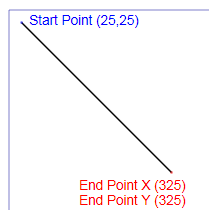
|
Two data values:
|
XPS_SEGMENT_TYPE_ARC_LARGE_CLOCKWISE
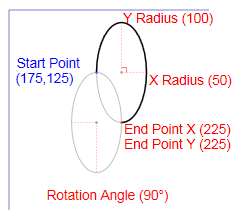
|
Five data values:
|
XPS_SEGMENT_TYPE_ARC_SMALL_CLOCKWISE
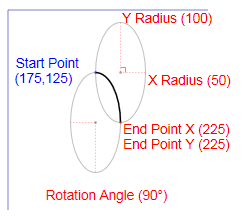
|
Five data values:
|
XPS_SEGMENT_TYPE_ARC_LARGE_COUNTERCLOCKWISE
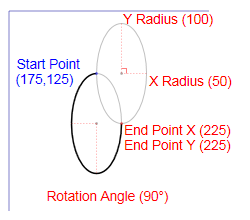
|
Five data values:
|
XPS_SEGMENT_TYPE_ARC_SMALL_COUNTERCLOCKWISE
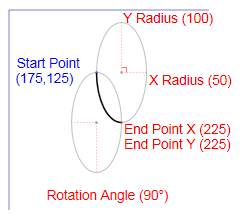
|
Five data values:
|
XPS_SEGMENT_TYPE_BEZIER
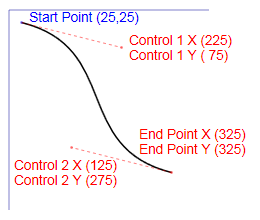
|
Six data values:
|
XPS_SEGMENT_TYPE_QUADRATIC_BEZIER
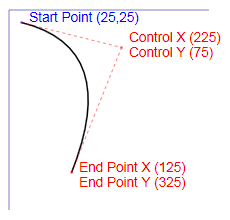
|
Four data values:
|
To get the segment types in the figure, call GetSegmentTypes.
The following code examples demonstrate one way to create and populate the buffers required by SetSegments.
In the first code example, the AddSegmentDataToArrays method takes the data points that describe a single segment and stores them in the three different data buffers required by the SetSegments method. The data buffers that are passed as arguments to AddSegmentDataToArrays are managed by the calling method as shown in the code example that follows AddSegmentDataToArrays.
HRESULT
AddSegmentDataToArrays(
XPS_SEGMENT_TYPE segmentType,
BOOL segmentStroke,
FLOAT *segmentPoints,
UINT32 *segmentsAvailable,
UINT32 *segmentPointsAvailable,
XPS_SEGMENT_TYPE **segmentTypeBuffer,
BOOL **segmentStrokeBuffer,
FLOAT **segmentPointBuffer
)
/*
Description:
Populates the buffers required by IXpsOMGeometryFigure::SetSegmentData
using data and buffers provided by the calling method.
Parameters:
segmentType
IN: XPS_SEGMENT_TYPE value that specifies the segment type for
the current segment.
segmentStroke
IN: BOOL value that specifies whether the current segment
is stroked.
*segmentPoints
IN: pointer to an array of FLOAT values that specify the
segment's data points. The number of values in the array
depend on the value of the segmentType parameter.
*segmentsAvailable
IN: the number of values that remain unused in the
segmentTypeBuffer and the segmentStrokeBuffer.
This value must be >= 1 when calling the method.
OUT: the number of values that remain unused in the
segmentTypeBuffer and the segmentStrokeBuffer after
segmentType and segmentStroke have been added. If the
method was successful, the returned value is one less
than the value passed in to the method.
*segmentPointsAvailable
IN: the number of values that remain unused in the
segmentPointBuffer. This value must be greater-than or equal
to the number of points required by the segmentType value.
OUT: the number of values that remain unused in the
segmentPointBuffer after the segmentPoints have been added.
The returned value depends on the segmentType value.
**segmentTypeBuffer
IN: the first free element in the buffer that receives the segment
type values.
OUT: the first free element in the buffer that receives the segment
type values. If the method is successful, this will be the element
after the element pointed to by this value before the method
was called.
**segmentStrokeBuffer
IN: the first free element in the buffer that receives the segment
stroke values.
OUT: the first free element in the buffer that receives the segment
stroke values. If the method is successful, this will be the element
after the element pointed to by this value before the method
was called.
**segmentPointBuffer
IN: the first free element in the buffer that receives the segment
point values.
OUT: the first free element in the buffer that receives the segment
point values. If the method is successful, the element referenced
by this value will depend on the segment type.
Remarks.
1) the buffers and values passed into this method are managed by
the calling method.
2) if the value returned in segmentsAvailable is 0, segmentTypeBuffer
and segmentStrokeBuffer point to invalid memory.
3) if the value returned in segmentPointsAvailable is 0, segmentPointBuffer
point to invalid memory.
*/
{
HRESULT hr = S_OK;
// test to see if there is sufficient space in the
// segmentTypeBuffer and the segmentStrokeBuffer before
// proceeding
if (*segmentsAvailable == 0)
{
hr = HRESULT_FROM_WIN32(ERROR_MORE_DATA);
}
if (SUCCEEDED(hr))
{
// process the data based on the segment type
switch (segmentType)
{
case XPS_SEGMENT_TYPE_ARC_LARGE_CLOCKWISE:
case XPS_SEGMENT_TYPE_ARC_LARGE_COUNTERCLOCKWISE:
case XPS_SEGMENT_TYPE_ARC_SMALL_CLOCKWISE:
case XPS_SEGMENT_TYPE_ARC_SMALL_COUNTERCLOCKWISE:
if (*segmentPointsAvailable >= 5)
{
// 5 data points
*(*segmentPointBuffer)++ = *segmentPoints++; //<arc end point (x)
*(*segmentPointBuffer)++ = *segmentPoints++; //<arc end point (y)
*(*segmentPointBuffer)++ = *segmentPoints++; //<arc radius (x)
*(*segmentPointBuffer)++ = *segmentPoints++; //<arc radius (y)
*(*segmentPointBuffer)++ = *segmentPoints++; //<arc angle
*segmentPointsAvailable -= 5;
}
else
{
hr = HRESULT_FROM_WIN32(ERROR_MORE_DATA);
}
break;
case XPS_SEGMENT_TYPE_BEZIER:
if (*segmentPointsAvailable >= 6)
{
// 6 data points
*(*segmentPointBuffer)++ = *segmentPoints++; //<control point 1 (x)
*(*segmentPointBuffer)++ = *segmentPoints++; //<control point 1 (y)
*(*segmentPointBuffer)++ = *segmentPoints++; //<control point 2 (x)
*(*segmentPointBuffer)++ = *segmentPoints++; //<control point 2 (y)
*(*segmentPointBuffer)++ = *segmentPoints++; //<end point (x)
*(*segmentPointBuffer)++ = *segmentPoints++; //<end point (y)
*segmentPointsAvailable -= 6;
}
else
{
hr = HRESULT_FROM_WIN32(ERROR_MORE_DATA);
}
break;
case XPS_SEGMENT_TYPE_LINE:
if (*segmentPointsAvailable >= 2)
{
// 2 data points
*(*segmentPointBuffer)++ = *segmentPoints++; //<end point (x)
*(*segmentPointBuffer)++ = *segmentPoints++; //<end point (y)
*segmentPointsAvailable -= 2;
}
else
{
hr = HRESULT_FROM_WIN32(ERROR_MORE_DATA);
}
break;
case XPS_SEGMENT_TYPE_QUADRATIC_BEZIER:
if (*segmentPointsAvailable >= 4)
{
// 4 data points
*(*segmentPointBuffer)++ = *segmentPoints++; //<control point 2 (x)
*(*segmentPointBuffer)++ = *segmentPoints++; //<control point 2 (y)
*(*segmentPointBuffer)++ = *segmentPoints++; //<end point (x)
*(*segmentPointBuffer)++ = *segmentPoints++; //<end point (y)
*segmentPointsAvailable -= 4;
}
else
{
hr = HRESULT_FROM_WIN32(ERROR_MORE_DATA);
}
break;
default:
// unrecognized segment type
hr = E_UNEXPECTED;
break;
}
}
if (SUCCEEDED(hr))
{
// Copy segment type and segment stroke values
// to array and decrement number of array values
// that remain unused.
//
// The space available for these operations was
// tested at the beginning of the method.
*(*segmentTypeBuffer)++ = segmentType;
*(*segmentStrokeBuffer)++ = segmentStroke;
*segmentsAvailable--;
}
return hr;
}
In this code example, UpdateSegmentData creates the data buffers required by the SetSegments method and calls the AddSegmentDataToArrays method from the preceding code example to populate them with the segment data. After the buffers have been populated, SetSegments is called to add this data to the geometry figure.
HRESULT
UpdateSegmentData (
IXpsOMGeometryFigure *geometryFigure,
UINT32 segmentCount,
UINT32 segmentDataCount
)
/*
Note that this method is not complete and only includes
the code necessary to show how the SetSegments call is used.
In this sample, the geometryFigure, segmentCount, and
segmentDataCount values are assumed to have been initialized
outside of this example.
*/
{
HRESULT hr = S_OK;
XPS_SEGMENT_TYPE segmentType = (XPS_SEGMENT_TYPE)0;
BOOL segmentStroke = FALSE;
FLOAT segmentPoints = 0;
UINT32 segmentsAvailable = 0;
UINT32 segmentPointsAvailable = 0;
// these buffers are sized and allocated based on
// the segment data to store.
XPS_SEGMENT_TYPE *segmentTypeBuffer = NULL;
BOOL *segmentStrokeBuffer = NULL;
FLOAT *segmentPointBuffer = NULL;
XPS_SEGMENT_TYPE *nextSegmentTypeValue = NULL;
BOOL *nextSegmentStrokeValue = NULL;
FLOAT *nextSegmentPointValue = NULL;
// segment data is created outside of this example
// allocate buffers as required using information
// from segment data. This can be dynamic or static
// depending on how the segment information is managed.
// This example assumes that the segment information
// does not change during this method.
// initialize "next" pointers to point to the first
// element in each array.
nextSegmentTypeValue = segmentTypeBuffer;
nextSegmentStrokeValue = segmentStrokeBuffer;
nextSegmentPointValue = segmentPointBuffer;
// for each segment in the figure, add the
// segment data to the buffers
hr = AddSegmentDataToArrays(
segmentType,
segmentStroke,
&segmentPoints,
&segmentsAvailable,
&segmentPointsAvailable,
&nextSegmentTypeValue,
&nextSegmentStrokeValue,
&nextSegmentPointValue);
if (SUCCEEDED(hr))
{
// set segment data
hr = geometryFigure->SetSegments (
segmentCount,
segmentDataCount,
segmentTypeBuffer,
segmentPointBuffer,
segmentStrokeBuffer);
}
// clean up buffers
return hr;
}
Requirements
| Requirement | Value |
|---|---|
| Minimum supported client | Windows 7, Windows Vista with SP2 and Platform Update for Windows Vista [desktop apps | UWP apps] |
| Minimum supported server | Windows Server 2008 R2, Windows Server 2008 with SP2 and Platform Update for Windows Server 2008 [desktop apps | UWP apps] |
| Target Platform | Windows |
| Header | xpsobjectmodel.h |
See also
Feedback
Coming soon: Throughout 2024 we will be phasing out GitHub Issues as the feedback mechanism for content and replacing it with a new feedback system. For more information see: https://aka.ms/ContentUserFeedback.
Submit and view feedback for